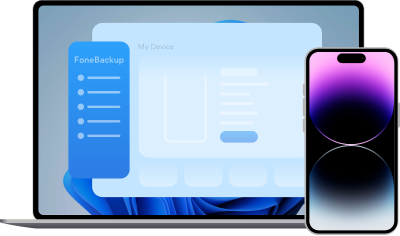Fix iPhone Not Showing in Windows File Explorer: 6 Ways
You may find your iPhone is not showing in Windows Explorer when you want to manage and transfer media files from iPhone, iPad, and iPod Touch to Windows PC. This article will guide you how to fix this issue easily.
My iPhone does not show up in Windows Explorer.
My iPhone 15 does not display in Windows Explorer but does in iTunes - I cannot transfer pictures from iPhone to PC. Why can't I see my iPhone in Windows Explorer and what can I do to fix it?
- Question from {{question-from}}
Why is iPhone not showing in Windows Explorer?
Windows Explorer/File Explorer can be an easy way to manage and move photos, and videos to a computer. You just connect your iPhone to a computer via a USB cable. However, some people reported that their iPhone not showing up in Window Explorer so they can’t view iPhone photos on PC. Here we conclude several reasons making this issue:
● Faulty or underqualified USB cable: Windows can’t read your iPhone with an underqualified or corrupted USB cable.
● Outdated Apple USB driver: A valid Apple USB driver is necessary to establish communication between an iOS device and a PC.
● Windows 10 media pack missing: In some cases, no media files can be found in Windows 10 system, it is because the OS is missing media files pack.
● You don't have full access to iTunes folder: If the iTunes folder is not full controlled by your computer, your iPhone will not appear on your Files Explorer.
Next, according to these causes, this post will demonstrate several fixes helping you to solve iPhone not showing up in File Explorer/Windows Explorer on Windows 11/10/8/7.
How to fix iPhone not showing in Windows 11, 10, 8, 7 File Explorer
Here we provide 6 methods to help you fix this problem. You can try these solutions one by one until your iPhone appears in Files Explorer. Or you can directly turn to an alternative way- an iOS transfer tool introduced in this post to transfer and manage iPhone data.
Method 1. Try the official or MFi-certified USB cable
Using an original USB cable or accessories that got the Made For iOS(MFi) certification helps you create a fine connection between the computer and your iPhone. Besides, uncertified USB cables may damage your iPhone, iPad, and iPod.
If you have already got the original or MFi USB cable, try different USB ports on your computer. A corrupted USB port can also be the cause of the connection issue.
Method 2. Update Apple USB driver
If your iPhone drives do not appearing in the Windows File Explorer, you may need to reinstall the Apple USB driver.
Apple USB driver is used to communicate data between your iOS device and a Windows computer. Usually, it will automatically install when you first time to connect your iPhone to a PC. It can be outdated and make your iOS not show in File Explorer.
Follow the steps below to see how to reinstall the Apple USB driver.
Step 1. Press the “Windows” key and “R” key to open Run box, and type “devmgmt.msc” on the box. Then press “Enter”.
Step 2. Once the Device Manager is launched, expand the “Portable Device”.
Step 3. Click “Update driver” to update the Apple driver.
✍Note: If there is no newer version available, you can reinstall the driver. Just click “Uninstall device” in Step 3. Disconnect and reconnect your iPhone, the Apple USB driver will automatically be reinstalled.
Method 3. Install Windows 10 media pack
If your computer is running with Windows 10, some iPhone media files are missing in Windows Explorer. That can be related to a Windows 10 bug that affects the communication functionality of your PC with media files on external drives, CD, digital devices.
To fix this issue, please check: https://support.microsoft.com/en-us/kb/3099229 to install the update.
Method 4. Change active drive in Device Manager
An outdated, invalid, or corrupted driver can cause your iPhone data not to show up in Windows. Another way to fix it is to change the active drive in Device Manager.
Step 1. Run Device Manager on your computer. Expand "Universal Serial Bus Controller". Go to the Device Manager on your computer and after that, expand “Universal Serial Bus Controllers”.
Step 2. Open “Apple Mobile Device USB Driver”.
Step 3. Choose the Driver tab. Click "Update Driver".
Step 4. Choose "Browse my computer for driver software". Then click "Let me pick from a list of device drivers on my computer".
Step 5. Click “MTP USB Device”. Click "Next" to continue. Then follow the instruction to complete it.
✍Note: MTP stands for Media Transfer Protocol. It actively used for transfer data between iPhone and computer.
Method 5. Make sure your computer has full access to the iTunes folder
iPhone not showing in Windows Explorer if you don't have full access to the iTunes folder. Here are the steps on how to solve this problem.
Step 1. Open "This PC" icon the desktop. Or press "Win" + "e" keys on your keyboards to open Files Explorer.
Step 2. Click "Music" on the left side of the window. Right-click on the iTunes folder, and click "Properties".
Step 3. Make sure the "Read Only" is unchecked. And click "Apply" or "OK" to save the change.
Step 4. If the problem is still here. Choose "Security" tab on the Properties of iTunes folder. Click "Edit".
Step 5. In this dialogue, tick "Full Control" or tick "Allow" next to the Full Control. And save the change.
Method 6. Download iCloud photos to PC
If your iPhone videos and images not showing in Windows Explorer, these media files may not be present on your iPhone.
We know that with iCloud enabled, your photos videos that shot or stored on other devices like the iPad will be uploaded to your iCloud storage. Then your iPhone will store previews of these media files. So they actually not on your iPhone, you can download them on your iPhone.
1. Go to the “Settings” app on your iPhone. Tap the “Photos” app on the Settings.
2. Check “Download and Keep Originals” on the Photos option.
Then open Windows Explorer to see if your pictures and videos folder is demonstrated on it.
Alternative to Windows Explorer to transfer data between iPhone and PC for free
Lots of users will use Windows Explorer to transfer and manage iPhone data on PC. However, it often failed to execute a task due to some problems like "iPhone not showing in Windows Explorer". And it seems not easier to use when you want to handle (import or export) a large amount of data.
If you want an easy way to transfer data between iOS and PC, you can rely on this professional backup & transfer tool named AOMEI FoneBackup.
🌟Highlights:
Easily transfer photos, videos, music, messages, contacts, etc. from iPhone/iPad/iPod Touch to Windows and vice versa.
Fast transfer speed allows you to transfer 1000 songs or pictures in 5 minutes.
All files can be kept in the original quality during the process.
Total USB connections ensure data security and stable transfer.
Various iOS models and versions are supported, including the iPhone 16 and iOS 18.
Step 1. Open AOMEI FoneBackup. To transfer data, click “Phone Transfer” on the left pane > Move the cursor to "iPhone to PC" and click "Get Started".
✍Note: You can click “PC to iPhone” to transfer files from PC to iPad, iPhone, and iPod Touch.
Step 2. Click the “+” icon and select the file type you want to transfer, and click “OK”.
Step 3. The selected files will be listed, and you can change a storage path from the "Transfer Settings". Then click “Start Transfer” to begin the operation.
Conclusion
So this post lists 6 methods to fix “iPhone not showing in Windows Explorer” in Windows. Hopefully, they can solve this problem. In addition, AOMEI FoneBackup is an effective and easy-to-use alternative to Windows File Explorer to transfer iPhone data to computer. Besides, this tool can also support sycing iCloud data and transferring WhatsApp data.

